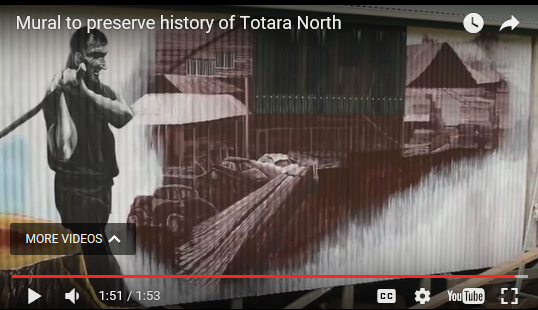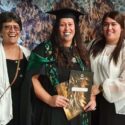Kuia and local historian, Moana Wood was born in Taupo Bay but moved to Tōtara North with her parents who came to work at the now derelict Lane and Brown Mill. The mill processed kauri and exotics from the time it was set up in 1870 until its closure in the 1990s.

A section of the mural depicts the old mill
Moana recalls childhood memories of the mill. “It was a playground. They had signs up – ‘Danger, don’t play on the trolleys, don’t play on the stacks, don’t, don’t, don’t…!’ – there were a lot of ‘don’t things’– no-one took any notice of them.
“Before the mill started, most of our people lived in the various maraes, different settlements. We are all related, we all belong to Whaingaroa but we have our own separate areas and identities.”
Kaitiaki
“We have a history of understanding what we call the kaitiaki, Pākeha call them gods, like Tane Mahuta, Tangaroa… all those. Our people were brought up with that. They were conservationists. Many of them were fishermen and farmers so when they were asked to come and mill native trees… they just moved from one job to another.“
Moana says the mill was welcomed by her tupuna .
“All our grandparents worked here. They weren’t (originally) skilled in the jobs that they were doing, but they were quick learners. They were already skilled in certain fields, so it was a natural thing for our people to slot in – one because of the great respect for Tane, which is the forest… respect of course for the kauri that they used for waka or whatever.”
Strong Irish community
“Tōtara North is also a very strong Irish community and many of the Irish people that came here were already… I suppose you would call them lumberjacks.”
She said that her tupuna worked in the forest, felling the kauri before sending the logs downstream where they were collected in temporary dams, lashed together and floated down the rivers into the harbour and around to Tōtara North.
It was highly skilled work and the men and women who rode the great logs raft were legendary. Mill work and shipbuilding were also highly skilled professions.
Over 70 ships, 300 workers
The mill had its own foundry and engineering shop and even its own telegraph office in the days before the post office came to town. The shipyard alone built over 70 ships in yards, some as large as 320 tons, and employed up to 300 workers at a time. It was the most significant ship building enterprise in the southern hemisphere and filled orders from all around the Pacific.
Read about a mural project capturing the history of Totora North here



